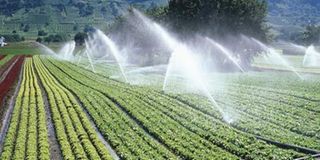Sh5.4bn set aside for irrigation

The deputy minister stated that the Sh5.4bn sought from the next government budget would be spent on two large dams and six boreholes whose water would be used to irrigate crop fields.PHOTO/FILE
What you need to know:
He said during a visit to the area recently that some Sh5.4 billion will be allocated during the 2014/15 financial year for revival of the scheme which collapsed in the 1990s.
Moshi. The government intends to revive the Lower Moshi Irrigation Scheme in the Kahe lowlands near Moshi Town, the deputy minister for Agriculture, Food Security and Cooperatives, Godfrey Zambi has revealed.
He said during a visit to the area recently that some Sh5.4 billion will be allocated during the 2014/15 financial year for revival of the scheme which collapsed in the 1990s.
He added that many farmers in Moshi Rural District lowlands, which are suitable for the cultivation of rice, sugarcane, fruits and other crops, have failed to attain their production targets because of water shortage.
The deputy minister stated that the Sh5.4bn sought from the next government budget would be spent on two large dams and six boreholes whose water would be used to irrigate crop fields.
Moshi Rural MP Cyril Chami told Mr Zambi that water was becoming too scarce for effective irrigation due to poor flow of the precious liquid from the surrounding highlands. This, according to the MP, has rendered the scheme useless to farmers unlike in the 1980s when it held great hope of increasing yields, especially for cash crop producers.
Decreasing water has also led to conflict over the resource among its multiple users in the area, Dr Chami said without giving details. The project was initiated with support from Japan.
The acting zonal director of the Irrigation Department with the Agriculture Department Pascal Shayo, said during its peak, the scheme enabled farmers to up rice output to six tonnes per hectare, an increase from the usual two tonnes.
“If irrigation would be revived like as was in the old days, I am sure production would rise to the past levels”, he pointed out,noting that some of the springs and rivers originating from the slopes of Mt Kilimanjaro have dried up.
The ambitious project was launched in the 1980s in the lowlands close to Moshi and was aimed to boost the production of rice, of the country’s staple foods, through irrigation.
The scheme also saw the introdution of new high yielding and early maturing paddy varieties. Field officials revealed recently that at the peak of the project, production of rice doubled after farmers increased land under cultivation to 1,600 hectares from 300 hectares Productivity of rice also went up from three tonnes per ha to six tonnes.




